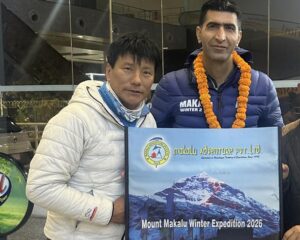Jost Kobusch continues to be patient with winter Everest. Climbing alone, he needs a durable weather window to return to the West Ridge and possibly get his first glimpse of the Hornbein Couloir.
This is why he has remained sheltered in Lobuche despite a brief spell of sunshine. “The forecast is good, with sunny days, but also very windy,” Kobusch said. “My hopes are now on a high-pressure front that should reach the area by the end of the month.”

Jost Kobusch takes a walk by the meteorological Pyramid in Lobuche. Photo: Jost Kobusch
Meanwhile, the German climber tries to stay fit and focused during these doldrums.
“I have routines in place,” Kobusch told ExplorersWeb. “I start every morning with reading, then I set a daily exercise goal. Later, I reward myself by watching a documentary.”
Harder this year
In a previous interview with ExplorersWeb, Kobusch admitted that conditions on the route are harder than on his previous attempt two years ago. In particular, a serac on top of the Lho La pass has forced the climber to search for an alternative line on the first section of the route.
“That big serac is constantly shedding chunks of ice and rocks, which trigger avalanches,” Kobusch explained. “So I start the route father left this time in order to minimize exposure. I couldn’t be happier to have made this choice, because the last time I went up, there were often avalanches to the right of where I was.”
Combining two routes
Kobusch’s route on Everest combines the 1979 Yugoslavian Direct, which follows the West Ridge from its beginning at the Lho La pass, and the 1963 American route opened by Tom Hornbein and Willy Unsoeld.
Unlike Kobusch, the Americans bypassed the Lho La and instead followed Everest’s normal route across the Khumbu Icefall until the Western Cwm and Camp 2. Then they climbed northward to the so-called West Shoulder. This gave them passage to the Tibetan side of the peak and the huge, steep couloir named after Hornbein. It starts roughly at 8,000m and leads directly to the summit.
Kobusch’s goal for this year is to leave the Yugoslavian route and follow the Americans’ way from the West Shoulder to the bottom of the Hornbein Couloir at 8,000m. Kobusch insists that the Couloir itself and hopefully the summit will have to wait until 2023.

On Pete Poston’s map of the routes of Everest, above, the Yugoslavian route is #5, in pink, and the American 1963 route is #3, in light green.

The yellow line shows the 1963 West Ridge American route on Everest, compared to the peak’s standard route in red. Graph: Great Tibet Tour






